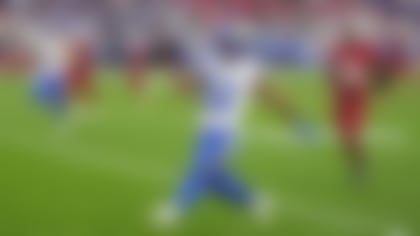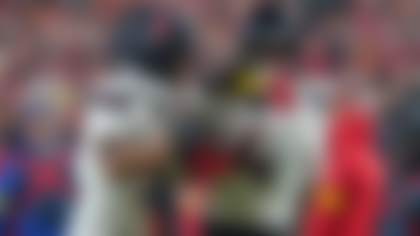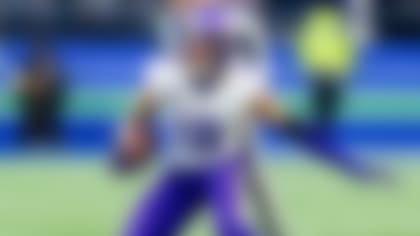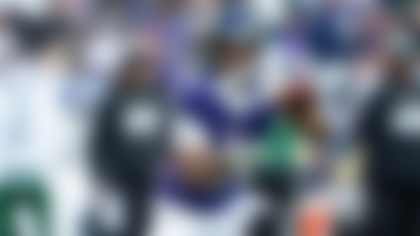By now, you should know that I really like applying structure in an unbiased way in order to contextualize football and take into account the situations that lead to the outcomes.
So, when I was asked to write about the most underperforming units of 2018, I created a model to measure performance. This model is a little more subjective than my game-performance-based models, because I had to use clues -- like offseason free-agent signings, salaries, preseason projections and when players were drafted -- and then adjust for major injuries over the course of the season in order to calibrate expectations.
For example, as soon as the Raiders shipped Khalil Mack off to the Bears a week before the start of the regular season, it became unreasonable to say that the Raiders had high potential as a pass-rushing unit in 2018. Of course, they proceeded to amass a league-low 13 sacks, which is even lower than their preseason projection sans Mack, but as a whole, the projection was low and the output was low, so they kind of performed like we expected.
As I built my model for this exercise, I also created criteria for on-field success that tied each player and position group to a positive or negative impact on their team's ability to win. Each play in each game was scored for its impact, and these scores were compared to my preseason projections. Since this article is about underperforming units, the areas the model flagged for negative impact were compared to areas of high preseason expectations.
Here are the 10 units that stand out the most. These areas should be high priorities for teams to address this offseason. All salary figures mentioned below are via Over The Cap.
Raiders' offensive line
There were high expectations for the Raiders' offense entering the season, especially their high-priced O-line, anchored by Kelechi Osemele (salary of $11.7 million per year, second most for a left guard), Gabe Jackson ($11 million per year, fourth most for a right guard) and Rodney Hudson ($8.9 million per year, seventh most for a center). Combine that with new head coach Jon Gruden's offensive mind, the union of Gruden and a QB potentially entering his prime in Derek Carr and the addition of tackle Kolton Miller via the 15th overall draft pick, and it's no wonder people were excited about the offensive possibilities, starting up front, in Oakland.
Fast forward to the end of the 2018 campaign: The Raiders finished 4-12 with 52 sacks allowed (tied for fifth most), with rookie Miller allowing 16 of those (per Pro Football Focus), along with the second-lowest average for rushing yards before contact (1.9). Those are not the kinds of results the club had in mind when it made such hefty investments along the front five.
Packers tight end
Under former GM Ted Thompson, the Packers did not pay a premium for free agents. Last offseason brought the hiring of a new GM, Brian Gutekunst, and a different approach. Green Bay signed veteran tight end Jimmy Graham to a three-year, $30 million deal last March, making him the highest-paid player at his position in average salary per year. During the 2017 season, Graham's 10 red-zone touchdowns as a Seahawk paced the NFL. The Packers seemed to be supporting the return of their elite quarterback from injury by providing him with a big, physical mismatch, especially in the red zone, after parting with receiver Jordy Nelson.
However, in 16 games this season with Aaron Rogers, Graham scored just two touchdowns, tying a career low. Furthermore, when taking into account the other ways tight ends contribute to an offense's ability to earn first downs and touchdowns -- including blocking and drawing attention from opposing defenses -- Graham doesn't crack the top 25 among tight ends in my metric (he ranks 27th). Graham averaged 39.8 receiving yards per game (ranking 16th among TEs) but only 2.1 in the red zone (31st).
Giants' offensive line
Addressing needs on the O-line was a major priority for the Giants last offseason. After a 3-13 finish, the team's efforts to protect Eli Manning and provide time and space for its skill players meant investing both in free agency (OT Note Solder) and the draft (OG Will Hernandez) to increase their offensive line's potential. Solder was signed to a four-year deal that made him the league's highest-paid offensive lineman in guaranteed salary, and Hernandez was drafted 34th overall (second round). One key departure -- center Weston Richburg -- was a negative, but the potential on the left side of the line was significantly increased.
To finish in last place in the NFC East again while allowing their quarterback to be sacked 47 times (tied for 10th most) was a huge disappointment. Solder allowed a team-high seven sacks and Hernandez five (third most on the team), according to PFF. Layering on computer-vision measurements of performance -- which track each player with a great level of precision -- shows that this season's line only performed better than last season's in five games. In other words, it performed no better, or worse, in 11 of 16 games.
Jaguars' defense
No defense had a greater impact on team wins than the Jags during the 2017 season -- this shouldn't be at all surprising. There are a ton of contextualized stats about the 2017 crew that speak to its dominance, but here's one way to capture how the whole unit worked together: They allowed the lowest percentage of first downs in the NFL (23.6) and had the second-most takeaways (33). While it wasn't likely that they would be able to replicate their league-leading seven defensive touchdowns in 2018, we did expect the D to be the source of at least enough wins for the Jaguars to repeat as AFC South champs.
Now, there are still elite individual components on this defense. This might be a little surprising, but the Jags only dropped to allowing first downs on 25.9 percent of plays (which actually is the second-lowest rate) this season. However, they allowed three points per game more than last season (19.8, up from 16.8) and nearly had their takeaways cut in half (only 17 in 2018), meaning they weren't setting their offense up for success like they did in 2017. The Jags' strategy of complementary football centered on their defense. Of course, Leonard Fournette missed eight games, and the team's continued issues at QB put more stress on the defense, but given where the expectations were for this crew entering the season, tallying just five wins (fourth in the AFC South) is a big underperformance.
Lions' passing offense
After the Lions hired defensive-minded Matt Patricia to be their head coach and retained offensive coordinator Jim Bob Cooter from the previous regime, they spent their first two draft picks on offensive players: left guard Frank Ragnow (20th pick) and running back Kerryon Johnson (43rd pick). Add those picks to the acquisition of veteran back LeGarrette Blount and a healthy season from 2016 first-round left tackle Taylor Decker, and it appeared the benefits of an improved run game would help stabilize the Matthew Stafford-led offense.
Well, the improvement in the running game occurred (they averaged 103.8 rushing yards per game, marking the first time they exceeded 100 since 2013), but they didn't reap the benefits of a more balanced offense. I measure wide receiver efficiency both when they are targeted in the passing game and by how they influence opposing defenses. I also measure pressures not only for proximity to the quarterback but also how it changed the QB's ability to earn first downs or touchdowns. Stafford's performance under pressure looked worse this season, but he was also under more disruptive pressure (up 10.2 percent from last season, the third-highest increase) and his wide receiver corps had lower efficiency ratings, which were compounded by the departure of Golden Tate at midseason (down 19.9 percent this season, second-biggest decrease). It's not all on Stafford, though -- it was their passing offense as a whole (O-line, receivers and Stafford) that underperformed relative to our expectations.
Vikings' offensive line
Expectations were already high here after the team came within a win of reaching the Super Bowl last season, and they really couldn't get any higher after Minnesota signed Kirk Cousins to a deal that made him the highest-paid player in NFL history in the offseason. It seemed like winning the NFC was the minimum expectation.
The problem is that the investments and strategy surrounding how to optimize their new quarterback fell short of expectations. According to Next Gen Stats, Cousins was under pressure on 217 dropbacks this season, the most of any quarterback in the NFL. When it came to being able to implement some of the higher-probability strategies to avoid these pressures from limiting drives -- like efficient rushing -- they weren't able to execute. One painful result of this: Their third-down conversion rate dropped from 43.5 percent (third best) to 35.8 percent (26th) this season. The O-line should be a main focus as they try to rebound this offseason.
Cardinals' rushing offense
With a dynamic running back like David Johnson in place, there was an expectation that the run game would help shorten rookie Josh Rosen's learning curve and that Johnson would be the pass-catching outlet for the QB when plays inevitably broke down.
Things didn't go according to plan, though. With 83.9 rushing yards per game, 3.78 yards per rush and a 23.6 percent first-down rate on rushes, Arizona ranked last in the NFL in each category. Investments and new concepts along the O-line project to help Johnson return to form, and that would be a great help to Rosen and new head coach Kliff Kingsbury.
Titans' passing offense
The addition last offseason of offensive coordinator Matt LaFleur, fresh from Sean McVay's high-octane Rams offensive staff, seemed to signal the end of "exotic smashmouth" in Tennessee. Corey Davis was on almost every fantasy expert's preseason list of sleepers, and Dion Lewis was forecasted to be the pass-catching back to help you win your PPR league.
However, with an average of 185.9 passing yards per game (29th) and 16 total passing touchdowns (tied for 28th), the passing game was not a source of strength for the Titans. Yes, there were injuries to key players, most notably quarterback Marcus Mariota, who didn't seem to be 100 percent at any point this season, and tight end Delanie Walker, who was lost for the season in Week 1. But the Titans' wide receiver efficiency rating didn't rank higher than 25th in any of their 16 games. Tennessee could be looking to improve its strategic investments (free agents or draft picks) this offseason to support the passing concepts their new OC will be implementing -- maybe perimeter speed? We need to see who's hired to replace LaFleur, the new Packers head coach, before determining the areas on offense where it makes the most sense to invest.
Bucs' quarterback play
This is really about Jameis Winston and not as much about Ryan Fitzpatrick, who exceeded expectations while filling in for Winston at the beginning of the season. We knew about Winston's three-game suspension prior to the season, so level-setting here means the expectation was for him to play up to his potential when he returned in Week 4 as a former first overall pick entering his fourth season.
While the running back efficiency for the Bucs did rate in the bottom third of the league, the combined efficiency of Winston's receivers ranked in the top 12. This makes his 14 interceptions in 11 games -- especially when the offense showed its potential under Fitzpatrick early in the season -- so maddening. Also, in metrics that aim to evaluate decision making, like taking sacks (versus throwing the ball away) and passing consistency by route (which factors in defensive formations), Winston had his least consistent season to date. Now, he did have great moments, but the game-to-game variation -- and play-to-play variation -- was dramatic. New head coach Bruce Arians has said Winston will be as well coached and prepared as he's ever been next season, and I can't argue with BA's past success, but with talk like that, the expectations are sure to be high for the QB1 again in 2019.
49ers' defensive blue chips
Here's the list of the first-rounders on the Niners' defense entering the 2018 season:
-- Jimmie Ward, defensive back: 30th overall pick, 2014
-- Arik Armstead, defensive lineman: 17th overall, 2015
-- DeForest Buckner, defensive lineman: seventh overall, 2016
-- Solomon Thomas, defensive lineman: third overall, 2017
-- Reuben Foster, linebacker: 31st overall, 2017 (released in November)
The Niners signed elite veteran corner Richard Sherman, who was coming off of injury, in the offseason and then focused on fortifying their offense around Jimmy Garoppolo with their first couple selections in the draft. This seemed to signal a belief that their prior draft picks would perform, especially along their defensive front. While sacks aren't the only measure of pressure, their total of 37 for the season (tied for 22nd) provides a quick way to contextualize their underperformance. I took a little deeper dive into their ability to create disruptive pressures and limit rushes -- they don't rank lower than 20th in either contextualized metric. When you take that into account and consider how many high-potential players they have on D, their poor third-down percentage (40.3, ranked 21st) is surprising. It will be interesting to see how defensive coordinator Robert Saleh, who spent three seasons as an assistant coach with Seattle's Legion of Boom defense, will scheme to create more disruptive pressure with the high-potential young group in his third season on the job.
Follow Cynthia Frelund on Twitter @cfrelund.












